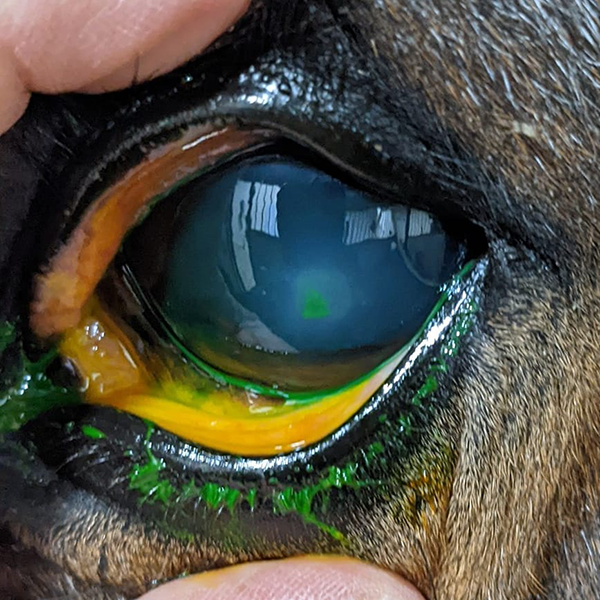Horse Health is Sponsored By: Cornerstone Equine Veterinary Services
Eye injuries are always a red alert emergency. Horses have nearly 360° vision because of the build and location of their eyes. But because horses’ eyes protrude from bony orbits, they are more susceptible to injury, i.e., bumping into objects or things can fly into their eyes.
Corneal injuries are the most common eye injury we see. Since we live in the Mississippi River Valley, fungal infections are always a risk. Depending on the severity of the injury to the cornea and the bacteria or fungus involved, damage to the eye can be rapid and potentially catastrophic.
It is very important to observe your horse’s eyes every day. Look from the front to check the angle of the lash line; sometimes a horse will barely squint and the eyelash line is tilted down, which can indicate eye pain. Superficial injuries to the cornea are actually much more painful than deep injuries because there is more nerve supply in the superficial layers.
Occasionally a horse bumps their head like we do. If there is some eyelid swelling, a dose of Banamine is given and, usually, they are good. However, anytime your horse’s eye looks abnormal, call your veterinarian. Hopefully, the eye injury can be treated on the farm, but in some cases, horses may need to come to the clinic to receive around-the-clock medication through an eyelid catheter known as a subpalpebral lavage kit (SPL). In other cases, we have to debride, or remove, part of the damaged cornea or inject the cornea with concentrated medication if there is a stromal abscess or infection deep in the corneal tissue. The worst-case scenario is removing the eye. This is why it is so critically important that eye injuries be caught early and treatment be started quickly. We’ve had at least one to three eye cases in the clinic every day for the past four months. Eye injuries are extremely common and definitely something to watch out for.
Veterinarians at Tennessee Equine Hospital West (Eads, Tenn.) also recommend seeing your veterinarian as soon as possible for any eye issues. “Swollen eyes - it’s the season! Is it allergies? Is it an injury? Inflammation from irritation or disease? Different medications are needed for different issues, so if your horse presents with a swollen eye, or is continually squinting, or has persistent tearing, give your veterinarian a call and get it checked out right away.”
Brett Robinson, DVM writes about Common Equine Eye Conditions for the American Association of Equine Practitioners (AAEP). He says, “Horses are particularly vulnerable to ocular trauma because their eyes are large and positioned on the sides of the head.” He stresses the “importance of early recognition and appropriate treatment.”
“Corneal ulcers are one of the most common eye conditions caused by trauma. The cornea is a transparent membrane in the front of the eye. Fluorescein stain dye adheres to and enables the veterinarian to identify defects there. Corneal pathology (disease or damage) generally results in opacity, and various color changes can accompany this process. Other signs include squinting, eyelid swelling, and discharge. Corneal ulcer treatment and prognosis depend on the defect’s depth.
“Eyelid lacerations are also common results of trauma. The classic case is an avulsion (tearing) that occurs when the horse ‘catches’ the eyelid on a sharp object. After examining for concurrent eye damage, the veterinarian usually sedates the horse, administers local anesthesia, prepares the skin, and repairs the laceration. Aftercare typically involves systemic anti-inflammatories and antibiotics.
“Another common eye issue is conjunctivitis. The conjunctiva is the mucous membrane covering the inside of the eyelids and white part of the eye. Clinical signs of conjunctivitis include ocular discharge, redness, and swelling of these tissues. Causes include allergies and insect hypersensitivity, which veterinarians can treat with anti-inflammatories, antihistamines, and environmental modifications.
“Uveitis is an inflammatory condition of the middle layer of the eye. Complications associated with uveitis are the number one cause of blindness in horses worldwide. Uveitis is categorized as acute or chronic/recurrent. Veterinarians base their initial diagnosis on clinical signs of squinting, ocular discharge, corneal edema (swelling), blood or pus in the anterior (front) chamber, and miosis (small pupil), among others. Veterinarians consider uveitis to be immune-mediated with multiple causes, both infectious (Leptospirosis, Streptococcus, equine influenza, and equine herpesvirus) and noninfectious (trauma or tumors). Sometimes, veterinarians cannot identify a cause and must treat the eye symptomatically. Most horses with the acute form initially respond well to symptomatic treatment, but the long-term prognosis might be guarded because of recurrence, and each inflammatory episode causes further eye damage.
“If you suspect an issue with your horse’s eye, early detection and veterinary attention will help ensure the best possible outcome.”










